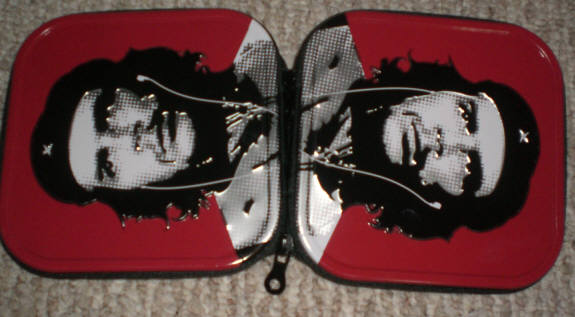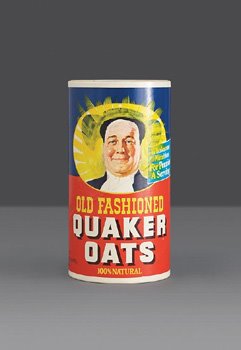The case of leftist icons is therefore an interesting one. Dedicated radicals may find the commercial or humorous appropriation of their heroes a sacrilege. Conservatives, by contrast (though it can be hard to say who is more humorless) tend to worry primarily that the practice masks the "crimes" of the figures, romanticizing individuals whose political practices even their admirers would not accept in real life.

Two news stories, one older and one more recent, address some of these issues.
Last fall marked the 40th anniversary of the death of Che Guevara. Marc Lacey of the New York Times reported, "A Communist He Was, but Today Che Sells":
SANTA CLARA, Cuba, Oct. 8 -- Aleida Guevara March, the 46-year-old daughter of Che Guevara, says she can bear the Che T-shirts, the Che keychains, the Che postcards and Che paintings sold all over Cuba, not to mention the world.
At least some of the purchasers truly cherish Che, she says. On Monday she was surrounded by thousands of Che fans wearing his image here in Santa Clara, where her father's remains are kept, and where she sat in the front row of a ceremony to observe the 40th anniversary of his death.
Raúl Castro, the acting president, attended. A message was read from his older brother Fidel, who ceded power in August 2006 after emergency surgery, likening his former comrade-in-arms to ''a flower that was plucked from his stem prematurely.''
But amid all the ceremony, what really gets to Ms. Guevara is the use of the man she calls Papi in ways that she says are completely removed from his revolutionary ideals, like when a designer recently put Che on a bikini.
In fact, 40 years after his death, Che -- born Ernesto Guevara de la Serna -- is as much a marketing tool as an international revolutionary icon. Which raises the question of what exactly does the sheer proliferation of his image -- the distant gaze, the scraggly beard and the beret adorned with a star -- mean in a decidedly capitalist world?
Even in Cuba, one of the world's last Communist bastions, Che is used both to make a buck and to make a point. ''He sells,'' acknowledged a Cuban shop clerk, who had Che after Che staring down from a wall full of T-shirts.
But at least here he is also used to inspire the next generation of Cubans. Schoolchildren invoke his name every morning, declaring with a salute, ''We want to be like Che.'' His quotations are recited almost as often as those of Fidel Castro.
[. . . . ]
But Che's mythic status as a homegrown revolutionary does not extend everywhere, even if his image does. When Target stores in the United States put his image on a CD carrying case last year, critics who consider him a murderer and symbol of totalitarianism pressed the retailer to pull the item.
''What next? Hitler backpacks? Pol Pot cookware? Pinochet pantyhose?'' Investor's Business Daily said in an editorial, calling the use of the image an example of ''tyrant-chic.''
[ . . . . ]
Ms. Guevara and her family, too, have tried to stop the marketing of Che's image in ways that they find abhorrent. She says they have reached out to lawyers in New York, whom she would not identify, to pursue companies the family thinks are misusing the image, not to sue them for damages, but to ask them to stop.
''We're not after money,'' she said. ''We just don't want him misused. He can be a universal person, but respect the image.''

More recently, Jed Perl, art critic of the New Republic, laid into an exhibit of contemporary Chinese art at the Guggenheim and the catalogue of similar pieces from the Saatchi Gallery:
There are times when art should be the last thing on an art critic's mind. The thunderous popularity of a number of contemporary Chinese artists compels a political analysis. Much of the work is powered by a startling and completely delusionary infatuation with Mao Zedong and the Cultural Revolution. This is more sinister than anything we have seen in the already fairly astonishing annals of radical chic. We are witnessing a globalized political whitewash job, with artists and assorted collectors, dealers, and sycophants pouring a thick layer of avant-garde double-talk over the infernal decade of suffering, destruction, and death that Mao unleashed on his country in 1966. And as we are also dealing with the house of mirrors that is the art world, I have no doubt that somebody is ready to explain that I am confusing appropriation with approbation or that fascism is just another way of spelling freedom. I must say, the theory people have a lot to answer for. But here is the bottom line: the global art world's burgeoning love affair with Mao and the Cultural Revolution makes a very neat fit with the current Chinese regime's efforts to sell itself as the authoritarian power that everybody can learn to love.To his credit, Perl also reflects on other ironies of the capitalist market:
A few weeks ago it was reported that Christie's International, in the run-up to the Summer Olympics, was privately offering for sale in Hong Kong one of the largest of Andy Warhol's portraits of Chairman Mao, with an asking price of $120 million. It is only natural that Warhol would figure somewhere in this sordid scene. [ . . . . ] Thus Warhol set the pattern for the new Chinese art, with its nauseating mix of romantic authoritarianism, ironic leftism, and capitalist realpolitik.
And let us also not forget that this grotesque book appears under the auspices of Charles Saatchi, the wealthy art collector who, in an earlier incarnation as an advertising wizard, brought Margaret Thatcher and the Conservatives to victory in England with the slogan "Labour Isn't Working." Well, in China the workers never stopped working. One almost doesn't know where to begin, but I am reminded of a recent remark by an architect named Mouzhan Majidi, who worked with Norman Foster on the construction of the new Terminal 3 at Beijing Capital International Airport. Majidi was glad to explain to The New York Times how much easier it is to build in China than in England, where there are so many rules and regulations and labor unions. "It evoked what it might have been like to build the pyramids," he commented. The pyramids? They were built by slaves(Sorry, Jed. You blew it there. The pyramids were built not by slaves, but by free laborers--though that does not materially detract from your essential point.)
After much further analysis, including reference to Saul Friedländer's Reflections of Nazism: An Essay on Kitsch and Death (1982), he concludes:
By the time they are done with the Cultural Revolution, it will be just another art event, neither more nor less significant than a performance by Joseph Beuys or Matthew Barney. These artists are dishonoring not only art, but life as well. So, too, are the collectors and curators and critics who abet them. What we have here is the most expensive propaganda the world has ever known.(more images)
No comments:
Post a Comment